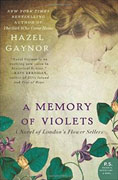A Memory of Violets
Hazel Gaynor
book reviews:
· general fiction
· chick lit/romance
· sci-fi/fantasy
· graphic novels
· nonfiction
· audio books
· author interviews
· children's books @
curledupkids.com
· DVD reviews @
curledupdvd.com
newsletter
win books
buy online
links
home
for authors
& publishers
for reviewers

 |
A Memory of Violets Hazel Gaynor William Morrow Paperback 432 pages February 2015 |
|
Illustrating the great dichotomy between wealth and poverty in Victorian England, Gaynor fashions a tale of women in both 1876 and 1912: twenty-one-year-old Tilly Harper and a lady she meets on a train to London in 1912, and orphan sisters Florrie and Rosie Flynn in 1876. The story begins with Tilly’s journey to London from the Lake District in the north to a job as assistant housemother at Mr. Shaw’s Home for Watercress and Flower Girls. Tilly has been assigned to Violet House, one of six residences. Each houses twelve girls, most with some disability, from crippling due to disease or accident, blindness, and the damaging effects of poverty on helpless children. Children are the collateral damage in a city overrun with poverty and crimes, a sharp contrast to the world inhabited by the wealthy and privileged.
Hoping to find distance from a past that still shadows her every action, Tilly looks forward to the demands of her new duties. Though at first overwhelmed by the faces of the girls in her charge and the myriad tasks she must perform every day, the home is an oasis in a sea of misery. Mrs. Shaw’s institution gives the girls not only a place to live but a way to earn money. Their hand-worked replicas of real flowers are in high demand, especially when the queen places a large order with the factory. Tilly is able to put her personal troubles aside when she discovers a diary hidden in the back of the closet in her room written in 1876 by Florrie Flynn as a way to communicate with her little sister, Rosie, who disappeared at four years old. The crippled Florrie manages to keep Rosie safe, even when the girls are orphaned and cast into the streets, until the day Rosie vanishes. In spite of Mrs. Shaw’s assistance and years of searching, Florrie is never able to find Rosie. She eventually dies of a broken heart, her pain described in the pages dedicated to her sister. Alone in her room, Tilly is often aware of the scent of violets, haunted by a sense that there is another in the room with her. Though many children suffer terrible fates on the streets of London, young Florrie is an example of those intended for assistance by Mr. Albert Shaw, whose homes for girls provide a much-need safe harbor, allowing the children meaningful lives with dignity and the opportunity to contribute to their care. With his Flower Village Orphanage in the north, girls such as Florrie are nursed back to health. Florrie is eventually brought to Violet House, where Tilly later finds the diary and sets out on a mission to learn Rosie’s fate. The fact that Tilly is able to resolve the mystery is but one example of a story that dilutes its message, slotting the novel firmly in the “women’s fiction” genre. Though historically accurate, a paean in fact for the great work of the real-life Mr. Albert Shaw and his family, there is much of the gentility of the era in the prose, a reaffirmation of women protected from reality, cushioning Tilly’s experiences in London from any truly frightening consequences. Save the description of the horrors endured by Florrie and Rosie in 1876, there is no real sense of danger, no threat to any of the characters, a world viewed through a soft lens. While the author remains true to the sensibilities of the characters and the way they conduct themselves, the predictable happy endings (true love and good will toward all) rob the novel of a sense of urgency, an inherent romanticism that is far removed from the true barbarity of the orphans’ circumstances. No, this story is cosseted firmly in the bosom of Victorian values. Originally published on Curled Up With A Good Book at www.curledup.com. © Luan Gaines, 2015 |
|
|
|
 Click here to learn more about this month's sponsor! |
|
| fiction · sf/f · comic books · nonfiction · audio newsletter · free book contest · buy books online review index · links · · authors & publishers reviewers |
|
| site by ELBO Computing Resources, Inc. | |
 Indeed, it is the person of Mrs. Marguerite Ingram who represents the higher levels of society, the woman Tilly meets on the train to London. Tilly finds the other woman charming, as Mrs. Ingram describes an anticipated meeting with her daughter, suggesting in parting that the two might meet again. As events conspire, the two women will have further contact, if not in a manner either of them might have imagined. Though far removed from the grueling poverty of London’s mean streets, Mrs. Ingram does play an important role in the novel, her unexpected generosity born of personal tragedy.
Indeed, it is the person of Mrs. Marguerite Ingram who represents the higher levels of society, the woman Tilly meets on the train to London. Tilly finds the other woman charming, as Mrs. Ingram describes an anticipated meeting with her daughter, suggesting in parting that the two might meet again. As events conspire, the two women will have further contact, if not in a manner either of them might have imagined. Though far removed from the grueling poverty of London’s mean streets, Mrs. Ingram does play an important role in the novel, her unexpected generosity born of personal tragedy.